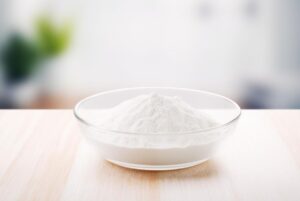 Monocalcium Phosphate Monohydrate and Monocalcium Phosphate Anhydrous are the same ingredients, still, there are some slight differences between them, let’s check it out.
Monocalcium Phosphate Monohydrate and Monocalcium Phosphate Anhydrous are the same ingredients, still, there are some slight differences between them, let’s check it out.
Firstly, let’s decipher their properties.
Monocalcium Phosphate Monohydrate (MCPM) contains one molecule of water (hence the term “monohydrate”). Its chemical formula is Ca(H2PO4)2·H2O.
Monocalcium Phosphate Anhydrous (MCP) lacks this water molecule, making it “anhydrous.” Its chemical formula is Ca(H2PO4)2.
Physical Properties: The hydration status can influence the physical appearance of these compounds. Monocalcium Phosphate Monohydrate typically appears as a crystalline substance due to the water molecule’s presence, while Monocalcium Phosphate Anhydrous often has a more powdery appearance.
Reactivity: Monocalcium Phosphate Monohydrate, with its water content, can sometimes have a slightly different reactivity rate compared to Monocalcium Phosphate Anhydrous, especially in processes that are sensitive to moisture.
Storage and Stability: Monocalcium Phosphate Anhydrous, might be more stable under conditions where moisture or humidity is a concern. It doesn’t readily absorb moisture from the environment, making it suitable for applications where moisture control is critical.
Solubility: While both compounds are soluble in water, their solubilities might differ slightly due to the presence or absence of the water molecule. Monocalcium Phosphate Monohydrate might be slightly more soluble in certain conditions due to its hydration.
Hygroscopicity: Monocalcium Phosphate Monohydrate, having an associated water molecule, may be less hygroscopic than its anhydrous counterpart. This means that Monocalcium Phosphate Anhydrous might have a higher tendency to absorb moisture from the environment compared to Monocalcium Phosphate Monohydrate.
Thermal Decomposition: The temperature at which these compounds decompose can vary. Monocalcium Phosphate Monohydrate, due to its water content, may begin to lose its water molecule at lower temperatures compared to the temperature at which Monocalcium Phosphate Anhydrous starts to decompose.
Density: The presence of the water molecule in Monocalcium Phosphate Monohydrate can influence its density. Typically, Monocalcium Phosphate Monohydrate might have a slightly lower bulk density compared to Monocalcium Phosphate Anhydrous.
Applications in Foods
Here’s a detailed breakdown of their applications in foods and the differences in their functionalities:
Acidity Regulator
Foods: Beverages, processed fruits, jellies, and preserves.
Difference: Both Monocalcium Phosphate Anhydrous and Monocalcium Phosphate Monohydrate can adjust and maintain the pH of food products, but Monocalcium Phosphate Monohydrate might offer slightly quicker pH stabilization due to its water content.
Dough Conditioner
Foods: Breads, rolls, and other baked goods.
Difference: Monocalcium Phosphate Monohydrate releases its water molecule during baking, which can influence the final texture. In contrast, Monocalcium Phosphate Anhydrous may offer more consistent conditioning across batches due to its anhydrous nature.
Thickener
Foods: Soups, gravies, sauces, and desserts.
Difference: Both act as thickeners by interacting with water in the formulation. However, Monocalcium Phosphate Anhydrous might provide a slightly thicker consistency compared to Monocalcium Phosphate Monohydrate in certain formulations due to its lack of bound water.
Leavening Agents
Foods: Cakes, muffins, cookies, and pancakes.
Difference: Monocalcium Phosphate Monohydrate, when heated, releases its water molecule, aiding in the leavening process, whereas Monocalcium Phosphate Anhydrous reacts with alkaline agents to release carbon dioxide, causing the dough or batter to rise.
Anti-caking Agent
Foods: Powdered and granulated foods like table salt, powdered sugar, and spice blends.
Difference: Monocalcium Phosphate Anhydrous, being anhydrous, may offer superior anti-caking properties, especially in humid environments, as it is less likely to absorb moisture compared to Monocalcium Phosphate Monohydrate.
Stabilizer
Foods: Dairy products like yogurt and ice cream, dressings, and sauces.
Difference: Both forms can prevent the separation of ingredients in emulsions. However, Monocalcium Phosphate Anhydrous might offer slightly better stabilization in certain formulations due to its anhydrous nature.
In essence, while Monocalcium Phosphate Monohydrate and Monocalcium Phosphate Anhydrous can be used interchangeably in many food applications, the subtle differences in their properties due to the presence or absence of a water molecule can influence their effectiveness in certain roles. Manufacturers often choose between them based on specific needs, desired outcomes, and other factors like cost and availability.




